|
For the medieval astronomer/astrologers the universe was a small place, the earth was the center, and events in the heavens
were orderly and designed to benefit humanity. The only change that was deemed appropriate was cyclic change such as
the (mostly) orderly motion of the planets on the sky or the daily travel of the sun around the heavens, for cyclic change
returns one to the starting point and so is not really change at all. In Europe of the Middle Ages this belief was elevated
to the level of religious dogma, and one dared challenge this worldview at considerable personal peril.
However, the Copernican revolution began a long process that changed completely our perception of the heavens and humanity's
place in the Universe. As most everyone is aware, observations and increased understanding demonstrated that the Universe
is enormous, that it has existed for periods that dwarf human lifetimes, and that we do not occupy the center of the
Universe (for there is no center). Probably less appreciated is a change with antecedents in events observed hundreds
of years ago, but that has accelerated at breathtaking pace over the last 30 years. As observational astronomy at
wavelengths other than visible light (Radio-Frequency, X-Ray, Gamma-Ray, Ultraviolet, ...) has become more commonplace,
we have begun to appreciate that the Universe is party to scenes of unimaginable violence. Far from an orderly stage for
stately and gentle physical processes, the Universe at various times and various places undergoes violent cataclysms
releasing energy on a scale to numb the mind of even the most analytic physical scientist.
The medieval natural philosopher would perhaps have had even greater difficulty accepting this insight than accepting the
Copernican hypothesis that the earth was not the center of the Universe, for it would have destroyed the strongly held
belief that the Universe existed as a nurturing cocoon for humanity. However, it is supremely ironic that these violent
processes that on the surface seem hostile to the place of humanity in the Universe are in fact essential to the production
of the present Universe. In particular, our modern understanding is that there would be no matter as we know it, no life as
we know it, and no humanity to contemplate these questions, in the absence of violent processes that would, of themselves,
destroy all life within countless light years. This lecture represents a brief introduction to the place of such violent
events in the evolution of the Universe.
The Big Bang
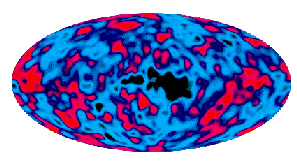 The modern understanding of cosmology
is that the Universe is some 10-20 billion years old (let's call it an even 15
billion years for our discussion), and that it came into being through an event
called, rather prosaically, the Big Bang. We now give a brief overview
of its main features; For a more extensive discussion of the present status of
these issues, see the U. S. National Academy of Sciences document Cosmology, a Research
Briefing.
The modern understanding of cosmology
is that the Universe is some 10-20 billion years old (let's call it an even 15
billion years for our discussion), and that it came into being through an event
called, rather prosaically, the Big Bang. We now give a brief overview
of its main features; For a more extensive discussion of the present status of
these issues, see the U. S. National Academy of Sciences document Cosmology, a Research
Briefing.
Expansion of the Universe
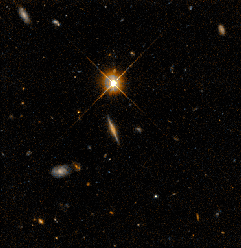 The galaxies
are all flying apart (on very large distance scales), with the velocity of
recession proportional to the distance between them. The adjacent image, taken
by the Wide-Field
and Planetary Camera (WFPC2) of the Hubble
Space Telescope, shows many galaxies billions of light years away. Most of
the fuzzy patches are galaxies containing billions of stars. The galaxies in this image are receding from us at high
velocities. The galaxies
are all flying apart (on very large distance scales), with the velocity of
recession proportional to the distance between them. The adjacent image, taken
by the Wide-Field
and Planetary Camera (WFPC2) of the Hubble
Space Telescope, shows many galaxies billions of light years away. Most of
the fuzzy patches are galaxies containing billions of stars. The galaxies in this image are receding from us at high
velocities.
The details of this expansion are dictated by the value of the Hubble
Constant. The objects furthest away from us appear to be receding at near
the velocity of
light. This expansion of the universe is a result of the original
explosion that created the universe-the Big Bang. The Big Bang did not happen in
space and in time; our modern understanding is that space and time as we
presently experience them are themselves created in the Big Bang. It makes no
more sense to ask what was before the Big Bang than to ask what is north of the
north pole.
The Cosmic Background Radiation
In every direction, there is a very low energy and very uniform
radiation that we see permeating the present universe. This is called the "3
Degree Kelvin Background Radiation". This radiation, which is detectable by
sensitive radio frequency detectors, is the afterglow of the Big Bang, cooled to
a faint whisper in the radio spectrum by the expansion of the Universe for 15
billion years. As shown in the adjacent intensity
map of the background radiation in different directions taken by the
Differential Microwave Radiometer on NASA's Cosmic Background
Explorer (COBE) Satellite, it is not completely uniform (though it is very
nearly so). In this image (click on it to get a larger version) red denotes
hotter fluctuations and blue and black denote cooler fluctuations around the
average. These fluctuations are extremely small, representing deviations from
the average of only about 1/100,000 of the average temperature of the observed
background radiation.
A small lack of uniformity in the background radiation is probably essential
to the ultimate formation of the galaxies. The luminous matter in the universe
that we observe on large scales is quite lumpy, as illustrated in the following
figure.

FIGURE: Data from the survey of galaxies. The voids and "walls" that form the
large-scale structure are mapped here by 11,000 galaxies. Our galaxy, the Milky
Way, is at the center. The outer radius is at a distance of approximately 450
million light-years. Obscuration by the plane of the Milky Way is responsible
for the missing pie-shaped sectors to the right and left.
The Growth of Large-Scale Structure
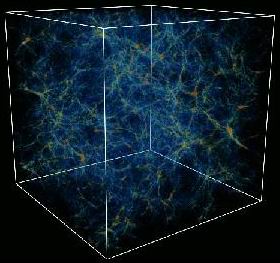
Thus, we require seed density fluctuations in the
early universe that allow matter to clump into galaxies and groups of galaxies.
Here is a link to a
set of MPEG movies showing computer simulations of large-scale structural
growth in the Universe. The adjacent image shows the end result of such a
simulation (click on the image to get a larger version). In this simulation
(Greg L. Bryan and Michael L. Norman, Grand Challenge
Cosmology Consortium), filaments grow that eventually exceed 100,000 light
years in length and surround gigantic bubbles of low-density gas. The
intersections of the filaments produce regions of high density (signified by
red) that are thought to generate bright X-ray
clusters of galaxies.
Matter in the Universe
The matter in the universe is created by the Big Bang, but not in the form
that we see today. First, there is very strong evidence that most of the matter
in the Universe is in the form of unseen or Dark
Matter matter that (at least so far) cannot be seen by standard
astronomical methods, but whose presence can be inferred because it influences
the Universe gravitationally. The nature of this dark matter is one of the major
cosmological issues of our time.
Second, the Big Bang produces mostly the light elements hydrogen and helium.
The heavier elements must be produced later, by stars.
Furthermore,
- Many of the heavier elements cannot be produced by stars in the stable
periods of their lives, they must be produced in violent explosions
associated with the death of stars.
- The heavier elements produced either in the stable portion of stellar
evolution, or in cataclysmic events, can only be distributed through the
universe by such explosive events.
Thus, the existence of the heavy elements, and the biology built on them,
depends crucially on violent processes taking place in stars and galaxies. Let
us now turn to a consideration of such events.
The Stars
The stars are
formed when great clouds of gas and dust called nebulae collapse
because of gravitation. If these clouds are massive enough, the temperature and
pressure in the central regions becomes high enough to ignite thermonuclear
reactions fusing hydrogen to helium, forming a star.
The Birth of Stars
Here is a Hubble Space Telescope
photograph of a region in the Eagle Nebula (M16)
that is thought to be forming stars
(click on the image to get a larger version (168 kB); here is an explanation of
what you are seeing):
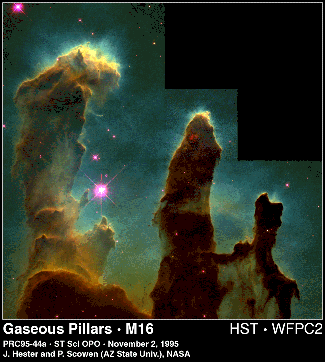
The vertical scale of this image is about a light year
(!!) and the glow is associated with hot young stars that have formed recently
in this nebula. Here is an expanded version of part of the preceding image
(click on the image to get a larger version (242 kB); here is an explanation of
what you are seeing):
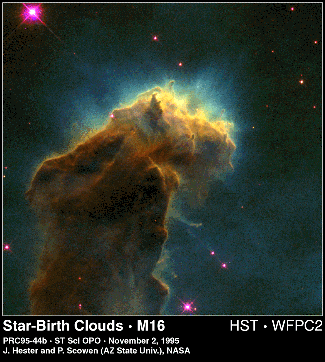
Here is even a further blowup of this region. The "tiny" fingers sticking out
from the main cloud in this image are regions larger than the solar system in
which stars are presently forming.
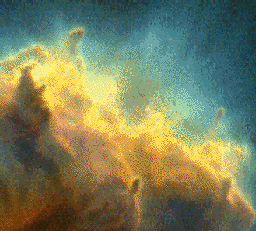
An MPEG
format movie (780 kB) of these star forming regions is available. (The original movie is available
from the Hubble Space Telescope.)
There are many other nebulae in which there is evidence of star formation.
For example, the Orion
Nebula (M42) is a nebula visible to the naked eye where many hot young stars are forming.
The Death of Stars
The birth of stars is
probably a rather orderly process, but their death can lead to extremely violent
explosions. Let us discuss three such explosive processes, novae, x-ray bursters, and supernovae.
Novae
A nova (plural: novae) is believed to occur when matter from a large
companion star accretes onto the surface of a white dwarf in a binary star
system:
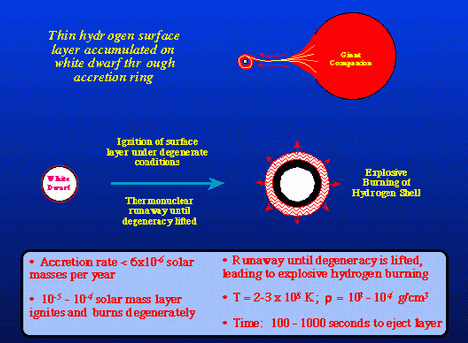
The white dwarf represents the death of an average star, and is not producing
energy from thermonuclear reactions. The surface of the white dwarf is quite hot
and dense (the hottest
star known is thought to be a white dwarf with a surface temperature of
approximately 200,000 degrees Celsius, which is 30 time hotter than the Sun's
surface). The accumlated material on the surface can get sufficiently hot and
dense to ignite a thermonuclear runaway that blows off the hot burning layer at
the surface, leading to rapid increase of the luminosity of the binary system.
Here is a Hubble Space Telescope photograph of the blown-off shell
responsible for a nova observed in 1992. Click on the image to get a larger
version, and click here for
an explanation of the figure.
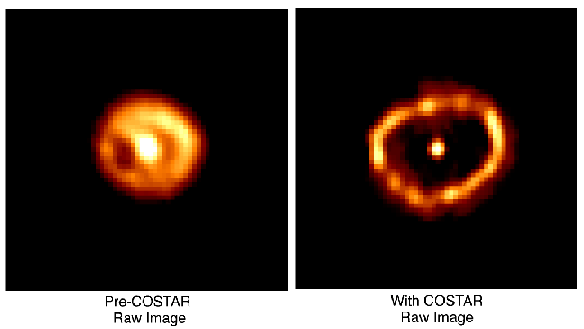
Novae are probably responsible for producing many heavy elements that cannot
be produced by other mechanisms.
X-Ray Bursters
An X-Ray Burster is believed to occur when matter from a large companion star
accretes onto the surface of a neutron star in a binary star system:
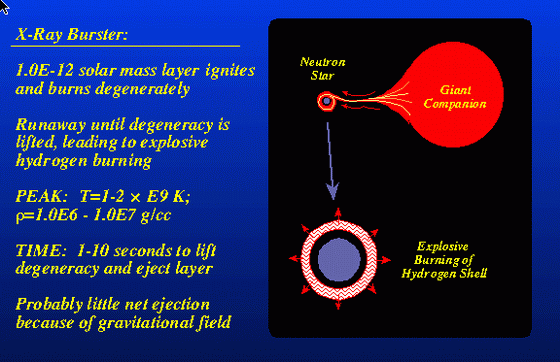
Thus an X-Ray Burster is very similar to a nova in
mechanism, but the energy associated with the burster is much higher because of
the stronger gravitational field of the neutron star relative to the white
dwarf. As a consequence, the light output is very strong in the X-Ray region of
the spectrum for the burster, whereas the nova produces mostly visible light.
The following Hubble Space
Telescope ultraviolet image represents the ultraviolet light from an X-Ray
burster in a star cluster for which the companion star appears to be a white
dwarf rather than a giant or supergiant star.

This binary star system has an orbital period of 11 minutes (the fastest
known) and the average separation of the two stars is less than half that of the
earth and moon. Click here for a
more detailed description.
Supernovae
Late in the life a a very massive star (10
or more times the mass of the sun) the tiny core of the star develops a layered
structure much like an onion, with heavier and heavier elements in deeper
layers, culminating with iron in the center:
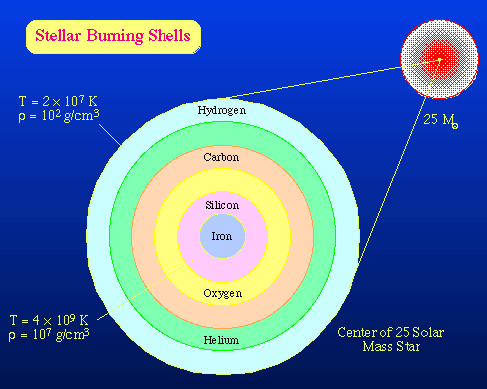
In very massive stars this situation eventually becomes unstable and the core
of the star collapses catastropically in a time of only a few thousandths of a
second. This collapse leads to an explosion called a (type II) Supernova
that blows off the outer layers of the star and produces a prodigious light show
that can rival the luminosity of an entire galaxy (billions of normal stars). As
spectacular as this is, most of the energy of the supernova is actually
contained in ghostly particles called neutrinos that are very difficult
(but not impossible) to detect. There are other types of supernovae that involve
a somewhat different mechanism associated with mass accretion by a white dwarf
in a binary system, but the final result is similar: a gigantic explosion that
destroys an entire star.
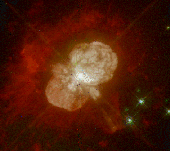 Finally we consider the strange case of the supermassive and violently
unstable star Eta
Carinae. The adjacent image shows a nebula larger than the Solar System that
was ejected in a violent outburst in 1841. For a time, this outburst made Eta
Carinae the second brightest star in the sky. Click on the image for a more
detailed discussion of a star that seems destined to come to a hideous end in a
few million years or less. Recent observations
suggest that Eta Carinae may also power the first ultraviolet
laser observed in the heavens.
Finally we consider the strange case of the supermassive and violently
unstable star Eta
Carinae. The adjacent image shows a nebula larger than the Solar System that
was ejected in a violent outburst in 1841. For a time, this outburst made Eta
Carinae the second brightest star in the sky. Click on the image for a more
detailed discussion of a star that seems destined to come to a hideous end in a
few million years or less. Recent observations
suggest that Eta Carinae may also power the first ultraviolet
laser observed in the heavens.
The Galaxies
The galaxies
are vast collections of stars, gas, and dust. Although many galaxies appear to
be rather quiet, others show signs of violent activity. Two common examples of
such activity are interacting galaxies, where two galaxies influence
each other gravitationally and in extreme cases may even collide, and active
galaxies exhibiting evidence of violent activity in the center or nucleus
of the galaxy.
Interacting Galaxies
There are a variety of instances where galaxies appear to be interacting with
each other enough to cause obvious distortions of the galaxies that interact.
These interactions may have a significant connections with the manner in which
galaxies
evolve with time.
 Interacting galaxies in the constellation Andromedae
as photographed with the Hubble Space
Telescope (click on the image for a larger version). This pair of
interacting spiral galaxies was first described in the Catalogue of Peculiar
Galaxies, compiled by Halton Arp in 1966. It is also pair number 64 in Igor
Karachentsev's catalog of binary galaxies. The larger member is strongly tidally
distorted, looking almost as though one side of the galaxy has been placed under
a magnifying glass. The edge-on companion, however, retains a relatively
undisturbed spiral disk, but has a luminous, heavily obscured but
infrared-bright, star-burst nucleus. The nucleus of the large spiral, by way of
a contrast, contains a low-ionization nuclear emission-line region (LINER),
which is indicative of much less activity than the bright nuclear HII region of
its companion. Interacting galaxies in the constellation Andromedae
as photographed with the Hubble Space
Telescope (click on the image for a larger version). This pair of
interacting spiral galaxies was first described in the Catalogue of Peculiar
Galaxies, compiled by Halton Arp in 1966. It is also pair number 64 in Igor
Karachentsev's catalog of binary galaxies. The larger member is strongly tidally
distorted, looking almost as though one side of the galaxy has been placed under
a magnifying glass. The edge-on companion, however, retains a relatively
undisturbed spiral disk, but has a luminous, heavily obscured but
infrared-bright, star-burst nucleus. The nucleus of the large spiral, by way of
a contrast, contains a low-ionization nuclear emission-line region (LINER),
which is indicative of much less activity than the bright nuclear HII region of
its companion.
We thus see an interesting example of the very different responses that
different galaxies can have to interaction with their companions: the large
galaxy has a shredded disk but essentially nothing in its nucleus, while the
small galaxy has an undisturbed disk but a very active nucleus.
Location: 02 19.6 +39 14 (1970.0), constellation of Andromeda.
Distance:
approximately 200 million light years.
Comments by e-mail to nsharp@noao.edu
Here is an example where there is evidence that two galaxies have actually
collided with each other, with a violent wave of star-forming material ejected
as a result. Click on the image to get a larger version (WARNING: 306 kB), and
click here
for an explanation of what you are seeing.
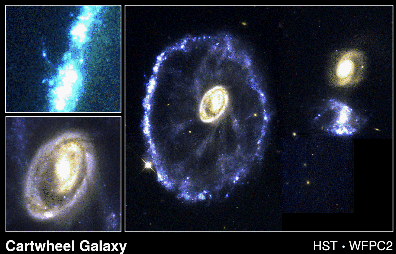
Other examples of galaxies where collisions appear to be taking place include
the The Sleeping Beauty
Galaxy (M64), where the center of the galaxy seems to be rotating in the
opposite direction from the outer regions, and the galaxy NGC 6240, where the
motion of objects in the center is extremely rapid and jumbled.
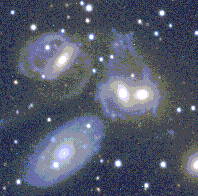 An extremely interesting example of possible galactic collisions
can be seen in Stephen's Quintet,
shown in the adjacent figure (click the image for a larger version). This is a
close grouping of the visual image of 5 galaxies (the cores of the 5 galaxies
are the brightest spots in the image). Four of these galaxies are probably
physically close because they have similar redshifts;
the 5th---in the lower left---is probably just accidentally in the line of sight
since it has a very different redshift. In this image, the 3 galaxies in the
upper left appear to be colliding with each other. Credit: Kitt Peak National Observatory. An extremely interesting example of possible galactic collisions
can be seen in Stephen's Quintet,
shown in the adjacent figure (click the image for a larger version). This is a
close grouping of the visual image of 5 galaxies (the cores of the 5 galaxies
are the brightest spots in the image). Four of these galaxies are probably
physically close because they have similar redshifts;
the 5th---in the lower left---is probably just accidentally in the line of sight
since it has a very different redshift. In this image, the 3 galaxies in the
upper left appear to be colliding with each other. Credit: Kitt Peak National Observatory.
The largest computers may be used to simulate the interaction of galaxies and
the resulting distortions and star formation. Here are three MPEG movies and
descriptive sound files showing computer simulations of colliding
galaxies:
The first two
movies show encounters between equal-mass galactic disks with two different
initial orientations of the disks. The third movie shows a simulated encounter
between a gas-rich disk
galaxy and a gas-poor dwarf
galaxy. In all three movies only the motion of the gas is shown---the unseen dark
matter influences the collisions through gravitational interactions, but
does not show in the simulations. Thus, in the third movie only the disk galaxy
is visible in the movie; the gas-poor dwarf galaxy is not seen directly. The
color coding in all three movies represents intensity of star formation: red
indicates high rates and blue denotes low rates of star formation.
Source: http://zebu.uoregon.edu/movie.html,
where further details on these simulations may be obtained.
Active Galaxies
Many galaxies exhibit signs of violent activity, usually in their cores. Such
galaxies are called active galaxies. The following Hubble Space Telescope photograph shows
the center of the giant elliptical galaxy M87, which is the
87th entry in the famous Messier
Catalog. Click on the image to get a larger version, and click here for a
explanation of what you are seeing in this image.

This galaxy is believed to contain a supermassive black hole
of several billion solar masses at its center. The observations indicate that
approximately 3 billion solar masses are concentrated in a region at the
galactic core that is only about the size of the solar system. The diagonal line
across the right image is believed to be a jet of high- speed electrons
approximately 6500 light years long that is being ejected from the galactic
nucleus by the black hole located there.
The following figure illustrates schematically Doppler
shift measurements made on the central region of M87 that suggest rapid
rotation of the matter near the center. Click on the image to get a larger
version, and click here for an
explanation of the figure.
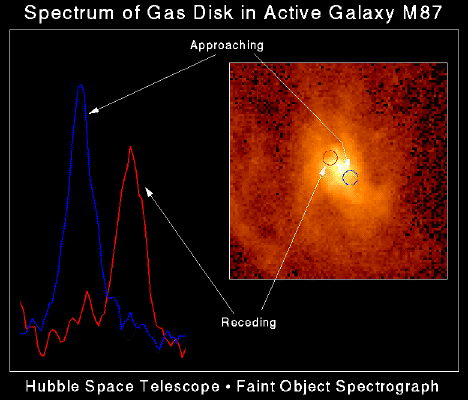
This is what would be expected for matter swirling around the supermassive
black hole, with part of it falling forever into the black hole and part of it
being ejected in the high-speed jet seen in the previous figure.
Here is another Hubble Space
Telescope photograph of an active giant elliptical galaxy that is suspected
of having a supermassive black hole at its center. The enormous radio frequency
jets shooting from the center of the galaxy (left image) are thought to be
associated with a black hole at the center of the gas and dust disk shown in the
Hubble photograph on the right. The black hole is presumably at the center of
the bright spot in the middle of the disk.

Click on the image for a larger version; click here for a
more detailed description.
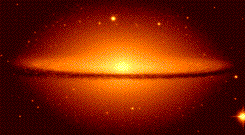 The image on the left is of the Sombrero Galaxy. This galaxy is a strong X-Ray emitter, and
unusually high velocities are observed for stars near its center; this raises
speculation that it may have a black hole of approximately 1 billion solar
masses at its core.
The image on the left is of the Sombrero Galaxy. This galaxy is a strong X-Ray emitter, and
unusually high velocities are observed for stars near its center; this raises
speculation that it may have a black hole of approximately 1 billion solar
masses at its core.
Finally, recent observations of the center of dense globular
clusters have suggested the possibility that massive black holes (thousands
of solar masses) may exist there also.
| 

